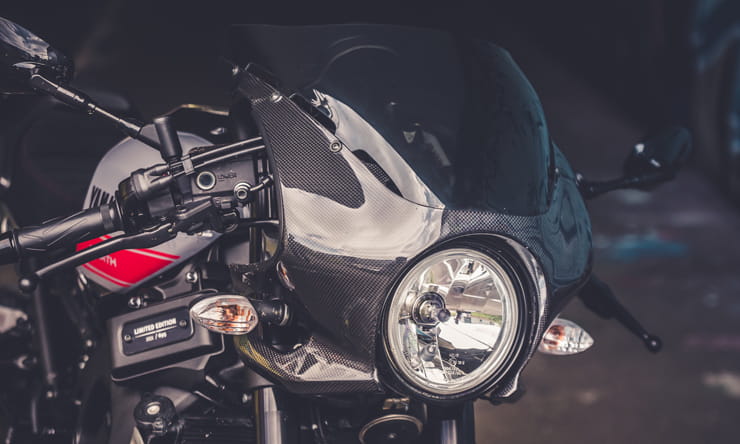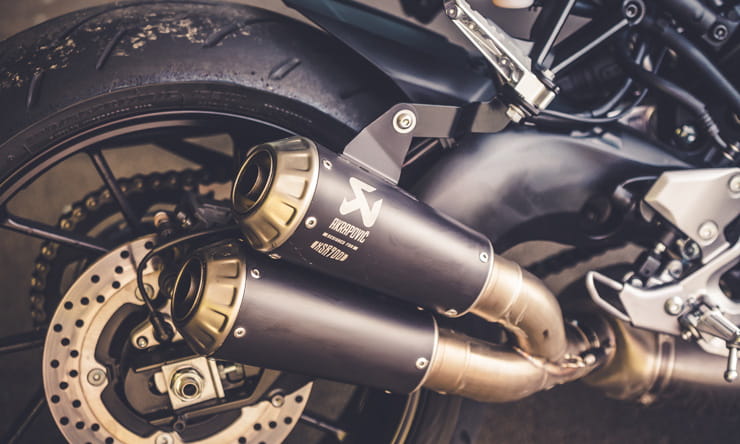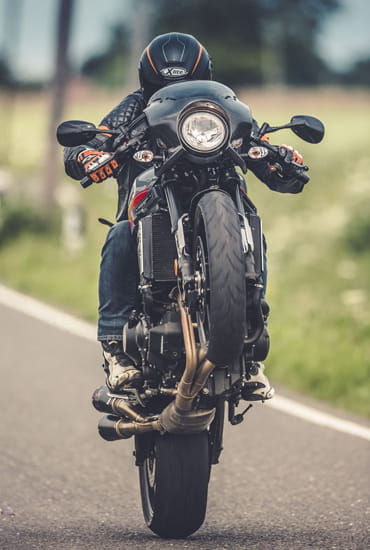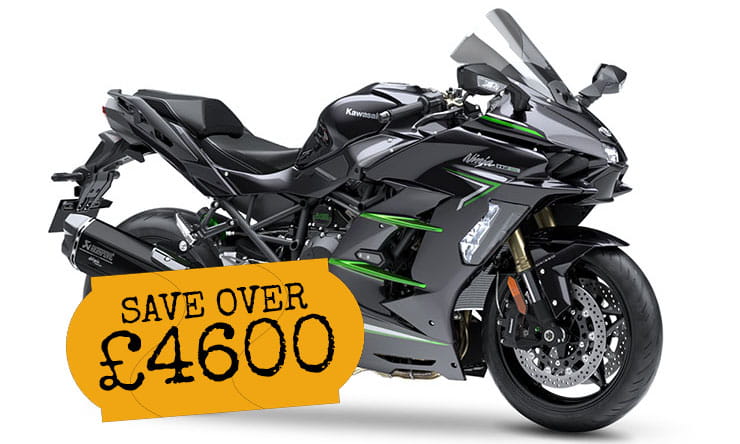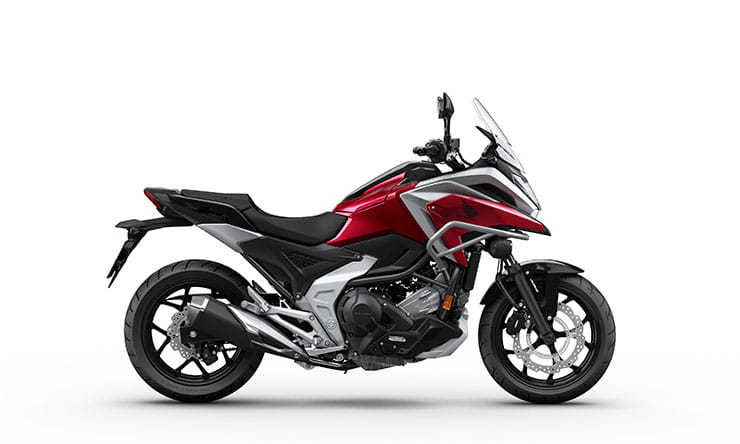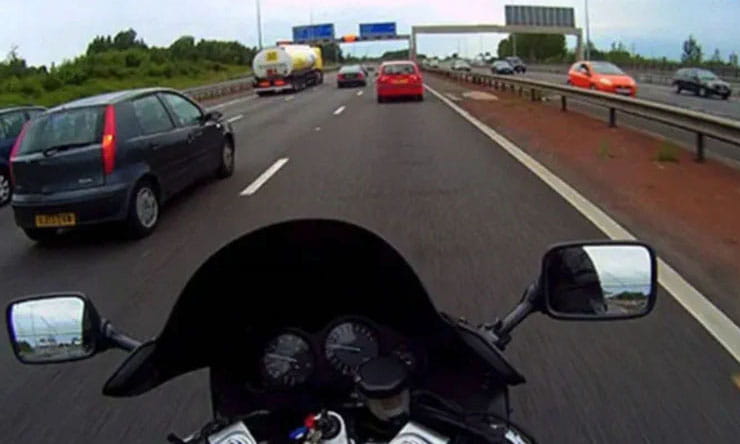The Yamaha XSR900 Abarth: a carbon fibre-rich café racer with a bonkers riding position
Say what you like about Yamaha, but there’s rarely a dull moment. It’s as if they’re always trying to lead us astray: from LCs to TDRs, FZRs to MT-10s, V-Max to T-Max, a seam of deeply unserious behaviour runs through Yamaha’s historical hysterical model line-up like laughing gas in the air-conditioning – or maybe there’s something in the water at Iwata R&D. You can rely on them to think outside the mould, break the box, upset the rule book and tear up the applecart.
The XSR900 Abarth is the latest in that line. There’s so much going on with the Abarth it’s hard to know where to begin. Is it with the absolutely barking-mad riding position? Or maybe Yamaha’s unique, limited edition collaboration with a car tuning company? How about that arresting café racer styling, and the Abarth’s spectacular abundance of carbon fibre – and that stonking afterburner seat cover?
Or instead perhaps we should discuss how the special XSR900 might be a pivotal moment, when customising previously functional machines into show-ponies is legitimised by factory blessing? And how maybe that splashing sound you can hear is the sound of hipsters jumping the shark...
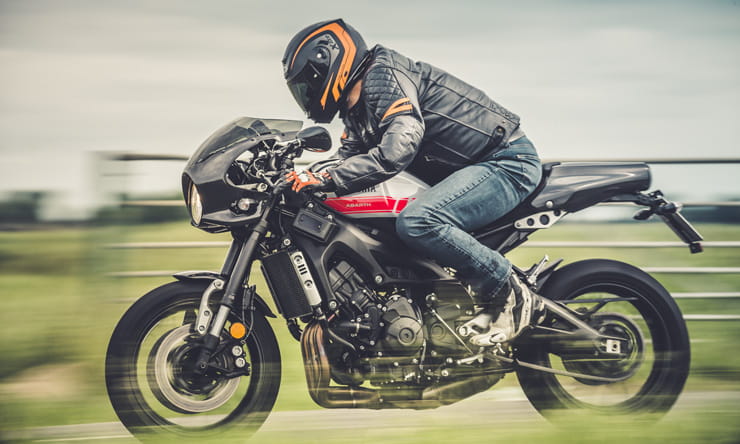
What’s an XSR900 Abarth?
The Abarth is an XSR900 – Yamaha’s retro-flavoured three-cylinder naked streetbike – with a carbon-based café racer makeover. It’s a limited edition – from a total, never-to-be-repeated, build of 695 bikes, 100 have come to the UK and 40 are already pre-sold via and online reservation process. Although ‘come to the UK’ isn’t quite the case; the bike arrives as a stripped XSR900 and a dealer bolts on the various Abarth components when it’s sold.
Anyway, over a standard XSR900, the Abarth has:
- a carbon fibre nose cone borrowed from the XJR1300 Racer,
- a set of crazy low ace bars from the XSR900’s accessories catalogue,
- a carbon front hugger and ‘afterburner’-style seat cover,
- suede accessory seat with red stitching,
- Akrapovič cans, another XSR900 accessory
- a tail tidy (XSR900 accessory, etc)
- a numbered plaque on the fuse box cover
- a one-off grey and red paint scheme with Abarth scorpion logos on fuel tank, front mudguard and tail.
All of which, you’ll notice, are cosmetic and ergonomic changes. So the Abarth’s suspension, wheels, brakes, clocks, pegs, engine and electronic rider aids are standard, as per the XSR900.
And that’s why it’s not a surprise to find the Abarth’s engine does all the things the standard XSR900’s motor does so, so well – the 847cc inline triple makes 115bhp at 10,000rpm and combines incredible, silky smoothness with a stunningly funky power delivery. It’s a brilliant engine, with a typically naughty power delivery geared by Yamaha to deliver mischief and illicit behaviour in large quantities. It can’t keep a straight face.
But what is a surprise is how dramatically the Abarth’s radical riding position affects the XSR’s steering, weight balance and general handling dynamic.
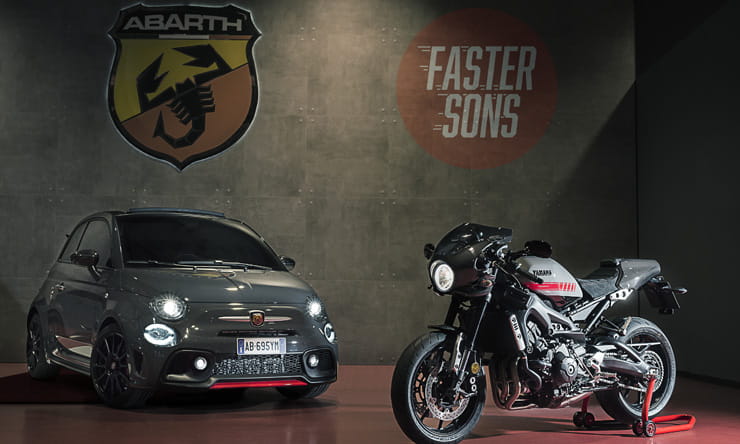
Who’s this Abarth lot, anyway?
In essence, the XSR900 Abarth is the fruit of a joint marketing exercise between two companies who go back a bit together. Abarth are an Italian, Fiat-owned tuning company, with a long history of tweaking the pants off small-bore motors. The connection with Yamaha is primarily MotoGP-based; Fiat have been team sponsors, and Abarth currently supply cars for the team. In 2007 Rossi raced an M1 in Abarth colours at Phillip Island and, in 2008, Abarth and Yamaha were a gnat’s away from producing a limited edition FZ1 – a prototype was built and shown, but the production bike never materialised.
The XSR900 Abarth is marketed alongside a special edition of Abarth’s souped-up Fiat 500 in the same grey and red livery, called the 695 – hence the limited number of 695 bikes.
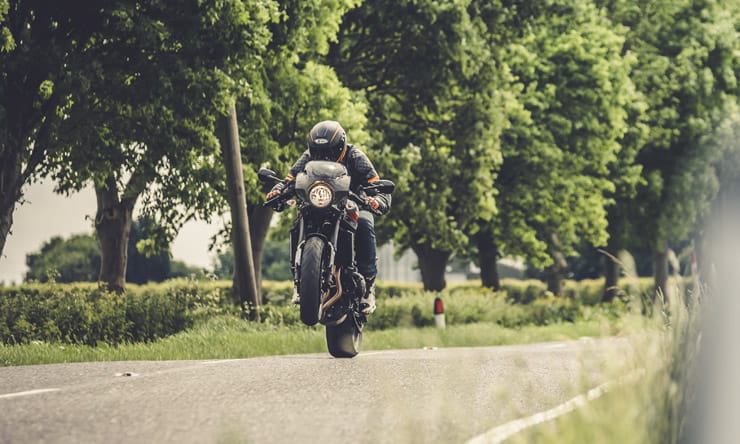
So what’s the XSR900 Abarth like to ride?
Step aboard your individually numbered motorcycle, sir... and, for better or worse, immediately discover what sportsbikes in the good old days really felt like.
The Abarth’s handlebars are, basically, inverted cowhorns – or ace bars – spun round in the clamps to sit low, below the line of the tank, spreading your hands and arms w-i-d-e. They aren’t clip-ons, so the top rail of the handlebar swoops down from the yoke clamps, just like an authentic café racer (presumably the ‘ace’ in ace bars comes from the café racer’s association with the Ace Café – the destination of choice for London bikers in the 50s and 60s).
And so, ironically, the Abarth is proud owner of what is surely the most radical sports riding position in modern motorcycling. Reaching forward from the Abarth’s seat and grabbing the grips is like leaning over a wall to pick up a sack of spuds – it makes a 2017 Fireblade feel like a sports tourer and I know because I rode them back to back. With your bum in the air (because the seat is high; 830mm, same as the XSR and 10mm higher than the MT-09), you’re suddenly aware of how short they cut bike jackets these days – you could park a bike in that crack, mate. It’s classic bum-up, head down, face planted squarely in front of the small LCD dial. It’s so close you almost have to back away a bit to get it in focus (it’s an age thing).
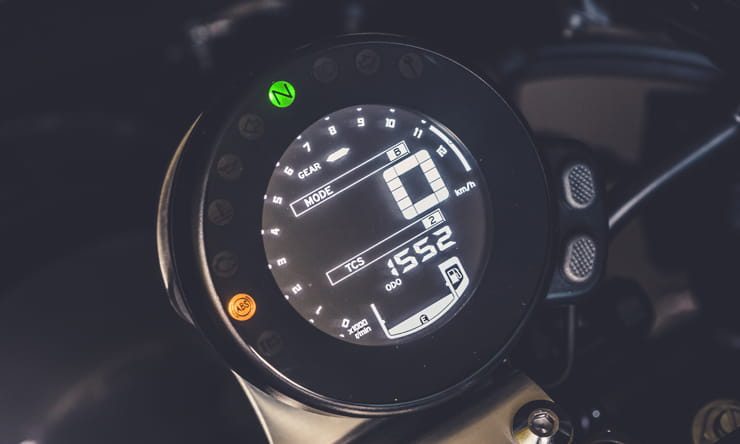
Deep breath, slide the starter switch forward and poke the triple. The 847cc inline three cylinder spins up with a swoosh – it’s less breathy and mechanically quieter than an equivalent Triumph engine, without the Hinckley bike’s characteristic primary drive whine. The Yamaha whips up and down the tacho with a delicious, free-revving vigour. And boy it’s smooth; slicker than a Triumph and they’re already about as creamy as a reciprocating piston engine gets.
Yamaha’s codename for the motor is CP3 – not half a Star Wars robot, it stands for ‘crossplane three’; a slightly misleading moniker that suggests its crank arrangement shares something with the R1 and MT-10’s crossplane inline four (with four crankpins spaced 90° apart).
In fact the XSR motor, like Triumph engines and also like Yamaha’s previous triples, the XS750 and 850 of the late 70s, runs a 120° crank – the crankpin angles are equi-spaced (3 x 120° = 360°). So in that sense it’s the same as the crossplane inline four (4 x 90° = 360°).
And it’s also the same in the sense the inertial torque produced by the engine is in harmony with its combustion torque – Yamaha’s theory of better throttle-to-rear wheel connection that helped propel Rossi and Lorenzo to so many MotoGP wins.
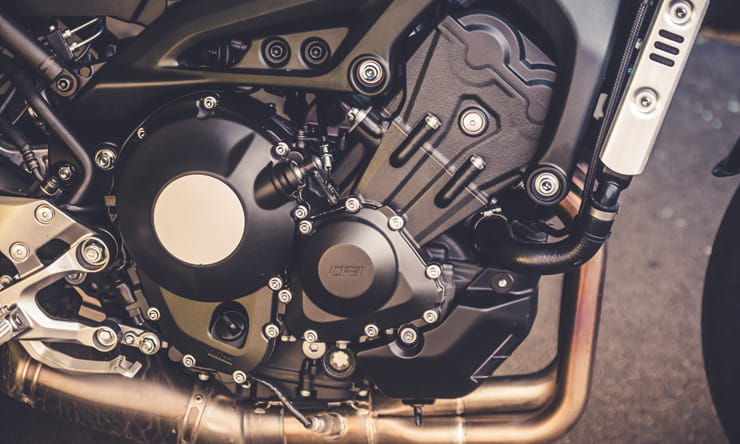
But where the inline triple really scores over inline fours is its smoothness – a 120° triple is in perfect balance. That means as one piston moves in one direction, its primary vibration is cancelled by the movement of the other two pistons. Not only that, but the nasty, high-pitched secondary vibration of inline fours that makes fingers and toes go numb (a vibration caused by the unavoidably uneven rate at which pistons move up and down) is also absent. The only complication is a rocking vibration – which the rider doesn’t really feel but the crank bearings definitely do – which requires a balancer shaft.
Almost none of which crosses your mind as you slip the XSR into gear – lovely gearbox (although it would be worth finding out of the MT-09’s quickshifter system is compatible with the XSR!) – and feed out the lightweight clutch. The Abarth pulls forward with deceptive pace; this bike is an ex-launch machine (number 6!) and is on German plates with a kph speedo. Unlike the XSR900 which can slip between metric and imperial a bit too easily with a long button push, the Abarth can’t. So I’m stuck translating kph into mph on the fly – times by two, divide by three?
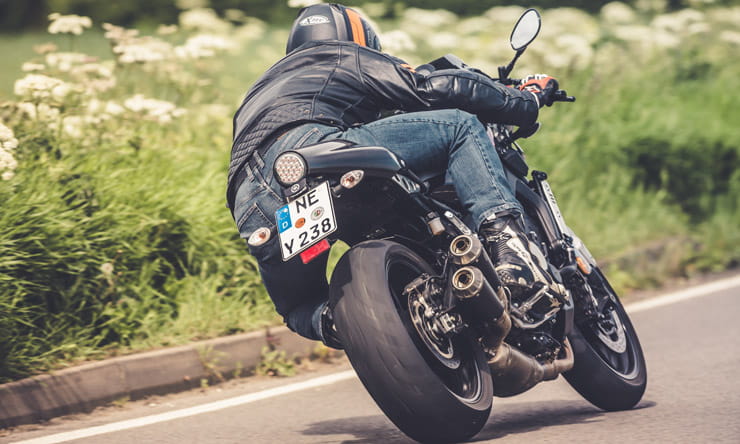
Either way, 180kph flashes up in dramatically short order as the triple decimates distance in a blur of short shifts, engine shimmering as it pummels out torque in a tidal wave made of Angel Delight. Head tight behind the bubble, the extreme riding position makes more sense as wind lifts your torso and takes the weight off your wrists, and you get the feeling you look totally cool doing it. It’s been a long time since I noticed so many drivers and riders pausing for a second glance at the bike I’m riding. Or maybe it’s the builder’s bum they can’t believe...
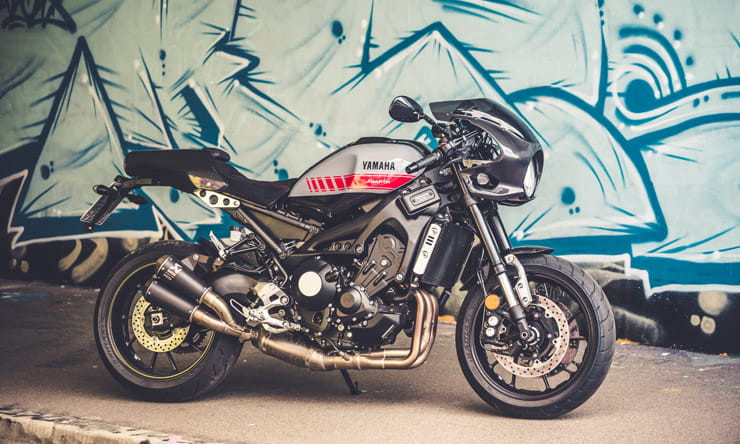
But there are a couple of problems with all the café racer cool. The first is the Abarth’s throttle response; even in the mildest of three modes (A, STD or B) it’s tricky to pick up the engine from nothing and dial in the right amount of throttle, and especially so when tramping on a bit; a second of a degree too much or too little throttle turns a smooth flow through a set of bends into a stop/start novice show. The hassle is exaggerated by the Abarth’s dropped bars – with wrists at such a severe angle, it’s hard to fully finesse the grip position. It’s hard to finesse the powerful front brake, too.
The second problem is chassis confidence. The Yam isn’t the most stable of machines: as it charges through its gears, a tendency to shimmy into a high frequency weave becomes more and more apparent. At post-legal speeds on crap roads it’s enough to make you back off – which sounds obvious, but it’s something I rarely have to do on any bike.
The Abarth’s sensitive steering also shows up at lower speeds when it hits a bump – doesn’t have to be big to deflect the steering; it’s called bump steer. Smooth, mid-speed roads are no problem – they’re exactly the kind of tarmac the Abarth excels on, as it did on its launch in Sardina a few months ago. But good old post-Brexit British bumps are a different story.
And with identical suspension to the XSR, the only difference is the change in the Abarth’s weight balance caused by the rider sitting so far forward. You can feel it as soon as you pull away; the bars take almost no effort to turn. It’s great for flicking deftly across town on an XSR900, with flat bars giving lots of control. But change the Abarth’s balance by putting more weight over the front, and it can feel constantly on the verge of kicking off.
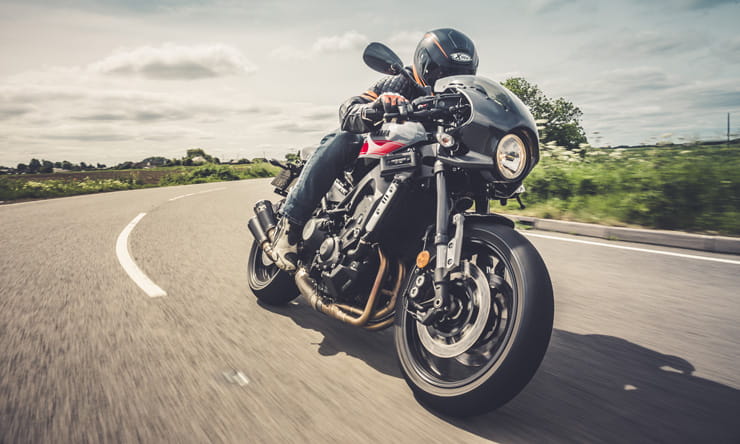
The Abarth, like the XSR900 and the MT-09, has longer spring travel than most other naked streetbikes – the front is positively adventure bike territory, with 137mm of travel when 120mm is the streetbike norm. Combined with a high seat it gives the Abarth a tall, slightly spindly feel – there’s something of the newly-born giraffe about it, as if it’s still finding its feet. This doesn’t translate as confidence – the Abarth’s front wheel is miles away, and it’s hard to trust the Bridgestone S20s because you can’t really feel them. A couple of slides at the front put paid to any notion of heroic knee down in jeans, and I settled for just thinking I looked the business, instead of actually doing it.
All of which leaves the Abarth handsome, devilishly entertaining, but imperfect. It looks eye-catching and special; a genuine head-turner. The motor is a gas, all wheelies and romping about and, although the riding position might be radical for some, it’s in keeping with the bike’s vibe (or lack of) – at speed, it’s not as uncomfortable as it looks. But the chassis can’t cash in on all that coolness and performance, hampered by a change in weight balance that hasn’t been accounted for in the bike’s set-up – which ultimately strands the Abarth looking a whole lot cooler than it can actually manage. Which, when you think about it, is pretty much what café racers were about in the first place.
TECHNICAL SPECIFICATIONS: Yamaha XSR900 Abarth
|
Engine Type
|
Inline three cylinder, 4 valves per cylinder, dohc, water-cooled
|
|
Displacement
|
847cc
|
|
Bore x stroke
|
78 x 59.1mm
|
|
Compression ratio
|
11.5:1
|
|
Power
|
113bhp @ 10,000 rpm
|
|
Torque
|
64 lb-ft @ 8500 rpm
|
|
Emissions
|
Euro 4
|
|
Consumption
|
46.3mpg (tested)
|
|
Frame
|
Alloy twin spar
|
|
Front suspension
|
Upside down 41mm fork (preload and rebound adjustment)
|
|
Front wheel travel
|
137mm
|
|
Front tyre
|
Bridgestone S20 radial 120/70 ZR17
|
|
Rear suspension
|
Monoshock; adjustable preload, compression and rebound
|
|
Rear wheel travel
|
130 mm
|
|
Rear tyre
|
Bridgestone S20 radial 180/55 ZR17
|
|
Front brake
|
2 x 298mm discs, 4-piston radial calipers, ABS
|
|
Rear brake
|
245mm disc, 2-piston caliper, ABS
|
|
Wheelbase
|
1440mm
|
|
Rake
|
25°
|
|
Trail
|
103mm
|
|
Fuel tank capacity
|
14 litres
|
|
Wet weight*
|
195kg
|
|
Seat height
|
830 mm
|
|
Max height
|
1140mm
|
|
Max width
|
815mm
|
|
Max length
|
2075mm
|
|
Number of seats
|
Dual seat
|
|
Warranty
|
24 months unlimited mileage
|
|
PRICE
|
£9999
|
Who’s bought one?
At £9999, the Abarth costs £1700 more than a base XSR900, and only £800 less than a fully-funky MT-10. So far, from a UK allocation of around 100 bikes, 40 have been pre-sold in an online reservation process. Bike Social spoke to six of them at a special Abarth car owners day at Rockingham Raceway, mere days before their bikes were due to arrive.
Neil Watkinson, 45, company director
“I’ve currently got a BMW S1000RR – but I just liked the styling of the Abarth. It’s something different from the plastic 1000cc sportsbikes I’ve had for the last 20 years.
“I first saw the Yamaha on the internet, when it was shown at the Milan show last year. I know who Abarth are, but the whole Fiat tuning thing isn’t a factor: really, it’s just the styling of the bike I like. I’ve never ridden an XSR900 or a MT-09, so I’ve no idea what the engine is like. But I’ve had bikes all my life and I read the reviews, which were pretty good so I’m confident I’ll be happy with it. And it won’t depreciate much because it’s got that special edition thing.”
Mark Sibun, 52, company director
“I’m a bit of a born-again biker, riding a Honda CB1000R, which is a nice, sit-up, do-it-all bike. And I wanted something a bit different – not a run-of-the-mill sportsbike, but something with that orientation. Everyone raves about the XSR900 engine; the triple is supposed to be really good And it’s got traction control, rider modes, ABS, fuel injection... so the whole package was sold to me as a modern take on a classic theme.
“I saw it on a website first, last year, and thought ‘Yeah, that’s for me.’ YouTube’s a wonderful thing, saw it properly on there and really liked the look of it.”
Steve Valentine, 35, marine electrician
“I’ve got a Honda Transalp and a Suzuki Bandit 1200. I was actually on a ship, and a friend was talking about the XSR900. I don’t actually like modern-looking bikes, but when I saw the Abarth on the internet I thought it looked really nice. I signed up for an email, and when I saw it was coming over I went into my local dealer to enquire about it... and ended up putting a deposit down on one.
“I’ve never owned a café racer before, and I’m really into the heritage and tradition of that scene. And I love the Abarth’s styling – I think it looks beautiful.”
James McBride, 46, carpenter (and ex-TT racer)
“I stopped racing two years ago, and I’ve got two track bikes which I don’t ride that often any more. But I don’t actually ride on the road at the moment, and so that’s what the Abarth is for; filling my weekends up with something I can go out with my friends on, but which isn’t fast enough to get me in trouble. The Abarth hasn’t got a full fairing, hasn’t got 190bhp, won’t encourage me to go too fast... and it’s not a tourer or a scrambler. I wanted something that was just suitable; and a retro XSR900 just does it.
“I first saw the bike the day before the sales went online, January 16th, on Yamaha’s website. I knew something big was happening, because I’d had a nod from a dealer last year, who said Yamaha were up to some big things in 2017. I didn’t even know what an XSR900 was! But an MT-10 with an R1 engine; I’d end up tuning it. And I don’t like twins. So this was – will be – perfect.”
Matthew Jasper, 31, scrapyard worker
“I’ve got a supercharged Z1000 which I built, and a new Africa Twin – I’m not a Honda man but I absolutely love it. I first saw the Abarth in the press last year, and I read about the reservation process. I kept my ear out, and I’m friendly with my local Yamaha dealer – they let me know when it was coming up and asked me if I wanted to put my name down for it. I said yes – lovely. Then I got an email the next day telling me I’d got one... and so I was kind of led down this road!
“And it’s unusual for a car company and a motorcycle company to come together like this, so that plus the fact it’s made in limited numbers; I’m thinking investment for the future.”
Tommy Brentwood, 30, police response officer
“I’ve got a Yamaha R1, a Suzuki GSX-R750 SRAD, and a Husqvarna 610 – the hooligan bike. So I first saw the Abarth at the Motorcycle Live in Birmingham last November. I was wandering around, on the Yamaha stand, came across the Abarth and thought ‘Wow, that looks special.’ It was a nice a bike, crowds of people around it, fought through the queue for a sit on it... and thought, ‘This is extreme; a proper, factory café racer’. But modern too. It’s exactly what I’ve been looking for, for quite a while now. I couldn’t stretch to the price of a new Norton, so as soon as I heard the price of this – less then £10,000 – I had to get one.”



